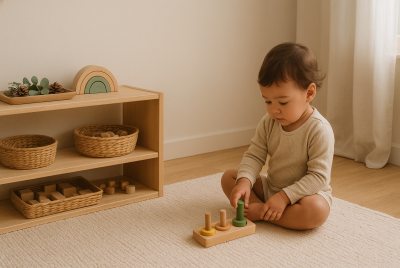How To Deal With Toddler Tantrums: 10 Strategies That Actually Work
We may earn a commission for purchases made using our links. Please see our disclosure to learn more.
Toddler tantrums can test even the calmest parent. If you’ve ever felt helpless during one of those full-body meltdowns in the cereal aisle, you’re not alone. Learning how to deal with toddler tantrums takes patience, empathy, and a few smart strategies. The good news? Tantrums are a normal part of child development—and with the right tools, you can navigate them with more confidence and less stress.
Understanding Why Toddler Tantrums Happen
Before we talk about solutions, it helps to know the “why.” Toddlers don’t throw tantrums to be bad—they’re expressing emotions they don’t yet have the skills to regulate. Frustration, hunger, overstimulation, exhaustion, or just not getting their way are common causes.
By understanding the root cause, you can respond in a way that’s calm and constructive rather than reactive.
Strategy 1: Stay Calm, Even If They Aren’t
Your calm is contagious. When your toddler loses control, the best thing you can do is hold onto yours. Take a deep breath, lower your voice, and speak slowly. Reacting with anger or frustration tends to escalate things quickly.
Need support? Apps like Insight Timer offer quick meditations to help you reset during stressful moments.
Strategy 2: Set Clear Boundaries Early On
Children thrive on structure. Set expectations ahead of time and be clear about what behaviors are unacceptable. The key is consistency—saying “no” one day and “okay” the next sends mixed signals that can lead to more tantrums.
Strategy 3: Offer Choices to Give Them Control
When toddlers feel powerless, tantrums often follow. Try asking, “Do you want the red shoes or the blue ones?” rather than, “Put on your shoes.” This simple choice can prevent a meltdown by giving your child a sense of autonomy.
Strategy 4: Use Distraction Techniques
Sometimes the best way to diffuse a tantrum is to shift their attention. A silly face, a sudden game of “I spy,” or pointing out something interesting can interrupt the emotional spiral before it goes full tilt.
Strategy 5: Praise Good Behavior (Not Just Silence)
Catch your child being good. It’s easy to focus on what’s going wrong, but acknowledging the good moments reinforces them. Try, “I love how you waited so patiently!” instead of only responding when they act out.
Strategy 6: Validate Their Feelings Without Giving In
You can say, “I see you’re upset because you want more cookies,” without handing over another treat. Validation doesn’t mean approval—it shows your child that their feelings are real and okay, but your limits still stand.
Strategy 7: Keep a Routine to Minimize Surprises
Kids feel safer when they know what to expect. Create a daily rhythm for meals, naps, and playtime. Unexpected changes can trigger emotional outbursts, so offer warnings like “Five more minutes before bedtime.”
Strategy 8: Use Time-In Instead of Time-Out
Rather than isolating your toddler during tough moments, consider a “time-in.” Sit together in a quiet corner and help them work through their big emotions. This fosters trust and promotes self-control.
Strategy 9: Model the Behavior You Want to See
Your toddler watches everything you do. If you yell, they’ll learn to yell. If you take deep breaths or verbalize your feelings calmly, they’ll eventually copy that too. Be the example you want them to follow.
Strategy 10: Be Consistent With Your Responses
Consistency builds security. If tantrums get a different reaction every time, your child may act out just to see what happens next. Decide on your boundaries and stick to them—even when it’s hard.

Recommended Products to Help You Manage Tantrums
Need a little extra help navigating those emotional waves? These parent-loved tools might just make your day a bit smoother:
- Melissa & Doug Responsibility Chart – Encourages positive behavior through visual tracking.
- Weighted Lap Pad for Kids – Offers calming sensory input for overwhelmed little ones.
- Slumberkins Emotional Learning Plush + Storybook – Reinforces emotional literacy in a way kids love—through cuddly characters and storytelling.
- Hatch Rest Sound Machine & Night Light – Helps reduce nighttime tantrums and promotes healthy sleep routines.
- Calm Down Sensory Bottles – Visual and tactile support for self-soothing during emotional meltdowns.
- Feelings Flashcards for Toddlers – Helps toddlers learn to identify and express emotions through pictures.
Research-Backed Insights on Toddler Tantrums
Science supports what many parents already suspect—tantrums are more than just a phase. Two key studies help illuminate the emotional and developmental drivers behind toddler tantrums, offering clarity and validation for the challenges parents face.
A longitudinal study on toddler tantrum behavior revealed that while tantrums are typical between the ages of 1 and 5, patterns such as extended duration or aggressive outbursts may signal a need for closer attention. Children with tantrums lasting over five minutes or occurring multiple times a day were more likely to experience behavioral challenges later. This research emphasizes the value of consistent routines and calm responses in helping toddlers develop emotional regulation.
Another comprehensive review on managing toddler tantrums highlights the importance of proactive parenting techniques and early intervention. It encourages structured routines, emotional validation, and consistent boundaries—core components of tantrum prevention and resolution.
Together, these findings reinforce the idea that tantrums are both a developmental milestone and an opportunity for teaching emotional skills.

Final Thoughts: Tantrums Aren’t the End of the World
While no one enjoys them, tantrums are part of growing up. They’re not a sign you’re failing—they’re a sign your child is developing emotionally. By responding with calm, empathy, and consistent strategies, you’ll not only reduce tantrums but also help your child build important life skills.
Parenting today comes with a unique set of challenges, from emotional overload to constant decision fatigue. If you’re navigating the ups and downs of modern caregiving, this deep dive into the new age of endless parenting offers helpful insight and solidarity.
FAQs About Toddler Tantrums
Q1: At what age do toddler tantrums usually start?
Tantrums typically begin around 18 months and can continue into the preschool years as kids develop emotional awareness and self-control.
Q2: Are tantrums a sign of behavioral issues?
Not necessarily. Frequent tantrums are normal in toddlers. However, if they’re extreme or persistent past age 5, it’s worth talking to a pediatrician.
Q3: Should I ignore a tantrum completely?
Ignoring may work for attention-seeking behavior, but always make sure your child is safe. Use the moment to model calm and provide reassurance afterward.
Q4: How long do tantrums last in toddlers?
Most tantrums last between 5 to 15 minutes. If they’re lasting much longer, check for underlying needs like hunger, fatigue, or overstimulation.
Q5: Can tantrums be prevented?
Not entirely, but you can reduce them by keeping routines, offering choices, validating feelings, and staying calm and consistent.




